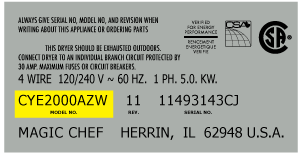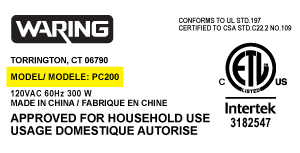4KMVWC430JW0 Maytag Washer - Instructions
Keep searches simple. Use keywords, e.g. "leaking", "pump", "broken" or "fit".
Hub had warn its grooved teeth off and washer wouldnt agitate
ordered hub and it shipped quickly. I was able to put the hub in place and screw the screws in. you want to tighten them down slowly and go around to each screw tightening a little at a time so you don't break the hub. as you tighten the screws down the hub slides down flush. its impossible to just push the hub on with your hand. Buttoned it back up and got caught up on laundry. good day when the washer is fixed.
Parts Used:
-
Allison from RICHFORD, NY
-
Difficulty Level:Easy
-
Total Repair Time:15 - 30 mins
-
Tools:Screw drivers
56 of 73 people
found this instruction helpful.
Was this instruction helpful to you?
Thank you for voting!
Noise, grinding sounds. Wash tub stopped turning but motor and cycles kept functioning. Process of elimination, must be the clutch assembly.
Easy, just followed the repair video. Recommend also ordering the drive belt. Bought one locally during my repair.
Parts Used:
-
David from BLOOMINGTON, IN
-
Difficulty Level:Easy
-
Total Repair Time:30 - 60 mins
-
Tools:Screw drivers, Socket set
58 of 80 people
found this instruction helpful.
Was this instruction helpful to you?
Thank you for voting!
Scratches in Surface
This product comes in a bottle with a brush like Liquid Paper. It goes on incredibly easy. A second coat might be needed. I wanted to prevent rust from setting in so I covered the scratches and dings. The paint is a little brighter since my washer is 10 years old but it still looks great.
Parts Used:
-
Michelle from Richardson, TX
-
Difficulty Level:Really Easy
-
Total Repair Time:Less than 15 mins
75 of 181 people
found this instruction helpful.
Was this instruction helpful to you?
Thank you for voting!
The upper bearing in the gearcase became rusty & very noisy due to shaft seal leakage.
Changing the gear case is a basic R and R operation since the gear case is a complete assembly riveted together. It is a bit challenging though getting to it because you have to totally disassemble the entire washer nearly every nut, bolt and screw. Fortunately the washer is fairly easy to work on and I am very mechanically inclined, but I did cheat a bit by watching some U-tube videos first. I couldn't find the same exact model washer as mine on U-tube but there were enough similar units to obtain the basic procedure. A thing I do when disassembling things is to take pictures of the way it's put together before removing stuff. It goes without saying that you first have to disconnect the power, the water hoses and it helps to get the washer out away from the wall so you can work around it. You have to remove the top, back panels, and the inner and outer tubs first. After removing the inner and outer tubs I turned the washer upside down in order to gain access to the gear case so I wouldn't have to stand on my head or lay down. Remove everything attached to the gear case (take picture) and use a strap wrench (or a strong friend) to hold the large pulley while removing the retaining nut. To remove the condenser (large round thing in black plastic retainer) rotate it counter clockwise and lift out, it doesn't snap out. I was very happy to see that the new gear case came with the shaft seal already installed so with a small amount of liquid dish soap around the outside of the rubber it allowed a nice slip fit back into the outer tub. All the parts that were removed pretty much will only fit one way so you don't have to worry too much about how everything goes back together. After reassembly and hooking up the washer again be sure to perform the calibration procedure before you turn on the water. Instructions came in the box with the gear case. Here is a side bar: I am 76, my grandson and I replaced the gear case in just a few hours, It's no big deal. Now for the interesting part, when I ordered the replacement gear case by the old part number I was told it had been superseded by a new number so when the new unit arrived I discovered that the shaft and seal looked different so hopefully the water leaking into bearing won't happen again. I was going to drill the old gear case apart and replace the bad bearing so I am glad I didn't because the shaft and seal would continue to leak and ruin the bearing again so don't try that. One thing I would like to mention about this company from which I ordered the part was the amazing delivery, only 36 hours. I ordered the part Sunday evening late and Tuesday morning early it arrived. Wow, blew me away, also I live in California and apparently the company is in Nova Scotia, no sales tax, Woo Hoo.
Parts Used:
-
Craig from ANAHEIM, CA
-
Difficulty Level:Really Easy
-
Total Repair Time:More than 2 hours
-
Tools:Nutdriver, Pliers, Screw drivers, Socket set
20 of 23 people
found this instruction helpful.
Was this instruction helpful to you?
Thank you for voting!
Waher would not spin and made noise
Removed center cap, loosened center nut, pry lightly up on center plate and tap center nut. Center plate comes loose, remove nut, remove center plate. Pry lock clip out and remove, remove screw with electric impact (screw drive will work, but slower), remove drive hub. Install new drive hub (be sure to check screw hole alignment), install and tighten screws (be sure to follow a skip pattern and bring it down even), install lock clip, install center plate, install and tighten nut, replace center cap. Done!
Parts Used:
-
Andrew from SYLVANIA, OH
-
Difficulty Level:Very Easy
-
Total Repair Time:Less than 15 mins
-
Tools:Screw drivers, Wrench (Adjustable)
17 of 20 people
found this instruction helpful.
Was this instruction helpful to you?
Thank you for voting!
Noise, all the lubricant had leaked from the gearcase.
DO NOT do this repair from the top. The only thing needed to be removed from the top of the machine is the agitator and retaining clip. After removing these items, lay the machine on its front, on a table if you have a friend who will help. Remove the back cover. Simply disconnect the wiring, remove the water pump, the tub locking mechanism, the belt, and motor. Remove the four bolts holding the gearcase. It should come out with little effort. Remove the old tub seal. There should be a new one on the replacement. Lubricate the new seal. Dishwashing liquid worked great. Move the drive wheel from the old gearcase to the replacement part. All the parts originally removed will only fit one way. Reverse all the removal steps and you be should be ready to go. My only problem with the replacement was there was no groove in the new part spline for the tub retaining clip. Seemed to be no problem since the agitator is bolted on so the tub is going nowhere.
Parts Used:
-
larry from SOD, WV
-
Difficulty Level:Very Easy
-
Total Repair Time:30 - 60 mins
-
Tools:Nutdriver, Pliers, Screw drivers, Socket set
15 of 15 people
found this instruction helpful.
Was this instruction helpful to you?
Thank you for voting!
Making loud noises.
The video you sent me was very helpful told me the exact tools I needed and how to do it.
Thank you
Thank you
Parts Used:
-
Roy from BROOKLYN, NY
-
Difficulty Level:Really Easy
-
Total Repair Time:30 - 60 mins
-
Tools:Nutdriver, Pliers, Screw drivers, Socket set
15 of 21 people
found this instruction helpful.
Was this instruction helpful to you?
Thank you for voting!
The tub would spin but it was weak. The splines were stripped on the drive hub.
Pulled the agitator, un-screwed the drive hub, cleaned the splines on the transmission, vacuumed the debris out of the tub. The repair video said to put towels or something down in the tub so if you drop a screw it will catch it. Put it back together and re-calibrated it. It didn't want to go into the calibrate mode until i moved the mode switch all the way to the left and then right first. Good quality factory parts!
Parts Used:
-
Doug from EAU CLAIRE, MI
-
Difficulty Level:Easy
-
Total Repair Time:30 - 60 mins
-
Tools:Nutdriver, Screw drivers, Socket set
10 of 11 people
found this instruction helpful.
Was this instruction helpful to you?
Thank you for voting!
Screeching noise when starting the washing cycle. Especially with heavy loads.
The belt in this model is underneath the washing machine. Disconnect water lines and power cords, set up the drain hose in a bucket to avoid water spilling on the floor, tip the washing machine on its back, remove two bolt screws holding the plastic covering the belt, remove the old belt, and install the new one.
Parts Used:
-
Armando from UNION CITY, CA
-
Difficulty Level:Really Easy
-
Total Repair Time:Less than 15 mins
-
Tools:Socket set
10 of 13 people
found this instruction helpful.
Was this instruction helpful to you?
Thank you for voting!
replaced drain hose that was missing
slipped the new drain hose on and with locking plyers slipped the wire clap in place after three trys
Parts Used:
-
Delmar from EAST TROY, WI
-
Difficulty Level:Really Easy
-
Total Repair Time:30 - 60 mins
-
Tools:Pliers
11 of 18 people
found this instruction helpful.
Was this instruction helpful to you?
Thank you for voting!
Slow Spin Cycle with Fast/Normal Agitator
My spin cycle was running, but spinning slowly and not drying my clothes. The agitator spun quickly like normal, but the basket did not spin fast. It seemed like something was slipping. I checked the belt, but it seemed fine and it was less than a year old. I was afraid that the transmission was going, but there wasn't any grinding sound of gears. Luckily the hub part description said that this could fix the slow Spin cycle. Over all the repair was easy, but pulling the agitator off was very difficult. I've got a strong grip and patience and after about 10 - 15 mintues of yanking on the agitator it came off. Don't try to use pliers as it will damage the plastic agitator. Replacing the hub drive and reassembly went very smoothly. The old hub drive wore out because it is plastic and connects to the metal drive shaft from the transmission. After years of torque, the hub will eventually strip out. Sooner depending on your usage and heavy duty cycles. In case you don't know, your machine might have the service manual in it on the inside of the body taped to the side. Mine helped me run through some troubleshooting steps and component tests to pinpoint to problem. Thanks Parts Select!
Parts Used:
-
Michael from AURORA, CO
-
Difficulty Level:A Bit Difficult
-
Total Repair Time:30 - 60 mins
-
Tools:Nutdriver, Socket set
7 of 7 people
found this instruction helpful.
Was this instruction helpful to you?
Thank you for voting!
drive hub splines were warn off. Thus no agitation was possible. Coins from laundry probably made increased friction to cause excessive ware on the splines.
Force the thin nylon strap around and down into the perimeter of the agitator. Draw it snug to the center. The strap must be long enough to make a complete loop up to the top of the tub. Insert a fairly stout wooden stick through the loop so that an upward prying motion of the stick applies a vertical force on the agitator. While the force is applied pound on the lower part of the agitator so that it will break it free from the motor's axel. Of course remove the center bolt first after removing the small hub cover.
Applying liquids to the connection did not help. Just a steady upward force and a few rubber hammer blows to the lower part of the agitator di the trick.
Applying liquids to the connection did not help. Just a steady upward force and a few rubber hammer blows to the lower part of the agitator di the trick.
Parts Used:
-
Wayne from HILTON, NY
-
Difficulty Level:A Bit Difficult
-
Total Repair Time:1- 2 hours
-
Tools:Screw drivers, Socket set
7 of 7 people
found this instruction helpful.
Was this instruction helpful to you?
Thank you for voting!
During the Spin cycle the washer was noisy and moved around
I watched the video and did exactly what they said to do. It was really easy. The key to the success was in the parts that were mailed to me it had a separate piece of paper telling you to "reset" the washer after doing the repair. I missed this when I watched the video. That was a critical part of the repair which required no tools to accomplish.
I have done 6 loads of wash and the washer has not made any crazy noises and hasn't moved!
I have done 6 loads of wash and the washer has not made any crazy noises and hasn't moved!
Parts Used:
-
JOHN from HERNANDO, FL
-
Difficulty Level:Really Easy
-
Total Repair Time:15 - 30 mins
-
Tools:Screw drivers, Socket set
7 of 8 people
found this instruction helpful.
Was this instruction helpful to you?
Thank you for voting!
After removing the bolt on top of the agitator, it agitator was very difficult to get out.
I watched the repair video on Partselect, it was very informative. In the video the agitator lifted right out easily, I was not so lucky. It took me and another gentleman about 4 hours to get the thing out. I watched other videos on ideas to remove, still no luck. Finally I cut the strap off of a carry all bag and was able to get it in around the agitator and slide it under it. After getting it under the agitator we were able to pull up on it and get it loose.
The rest of the repair was simple, cleaned everything, installed new part, and now washing machine is working like new again.
The rest of the repair was simple, cleaned everything, installed new part, and now washing machine is working like new again.
Parts Used:
-
John from SALEM, VA
-
Difficulty Level:Very Difficult
-
Total Repair Time:More than 2 hours
-
Tools:Screw drivers, Socket set
6 of 6 people
found this instruction helpful.
Was this instruction helpful to you?
Thank you for voting!
When the washer goes into a spin cycle, I would hear an intermittent loud clattering noise. I think the clutch teeth above (the cup part that is spring loaded) and the belted pulley's teeth below are not fully seating on each other during the spin cycle.
W10721967 Splutch Cam Kit
Assuming the pulley nut was properly tightened at the factory. I think this problem occurs because of ever-so-slight rounding of the splutch cam teeth from the actuator engaging and disengaging over whatever time frame there is before a clattering noise develops.
When I took off the 13mm nut using the adjustable strap tool, it felt tight to me...Was it put on as tight as it should have been at the factory? Who knows. I don't have the torque specification of this nut on that plastic pulley.
Watch the videos to remove and replace the belt cover and belt, actuator and splutch cam kit.
Pay particular attention to tightening up the nut. I put the pulley on and hand-tightened the nut. I used the adjustable strap tool and before I tightened everything, I pushed up on the pulley to press against the spring pressure in order to mesh the teeth together. After the nut was tight, I repositioned the strap tool and gave it another go, further tightening it. You see earlier that day, I only tightened it up once because I thought it was good and tight. I put everything back and within a half-hour it was clattering again and I could loosen the nut I thought was tight by hand! I fooled myself. That's why I did it twice, and don't be afraid to give it a good second tightening effort. Two weeks now and the wife is currently very happy.
Assuming the pulley nut was properly tightened at the factory. I think this problem occurs because of ever-so-slight rounding of the splutch cam teeth from the actuator engaging and disengaging over whatever time frame there is before a clattering noise develops.
When I took off the 13mm nut using the adjustable strap tool, it felt tight to me...Was it put on as tight as it should have been at the factory? Who knows. I don't have the torque specification of this nut on that plastic pulley.
Watch the videos to remove and replace the belt cover and belt, actuator and splutch cam kit.
Pay particular attention to tightening up the nut. I put the pulley on and hand-tightened the nut. I used the adjustable strap tool and before I tightened everything, I pushed up on the pulley to press against the spring pressure in order to mesh the teeth together. After the nut was tight, I repositioned the strap tool and gave it another go, further tightening it. You see earlier that day, I only tightened it up once because I thought it was good and tight. I put everything back and within a half-hour it was clattering again and I could loosen the nut I thought was tight by hand! I fooled myself. That's why I did it twice, and don't be afraid to give it a good second tightening effort. Two weeks now and the wife is currently very happy.
Parts Used:
-
TERRY from WAUKEE, IA
-
Difficulty Level:Easy
-
Total Repair Time:15 - 30 mins
-
Tools:Nutdriver, Socket set
8 of 13 people
found this instruction helpful.
Was this instruction helpful to you?
Thank you for voting!






























